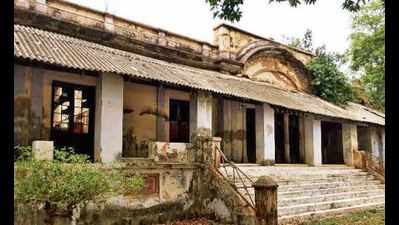- News
- City News
- lucknow News
- Nawabs' legacy crumbles in Awadh's first capital
Trending
This story is from June 14, 2016
Nawabs' legacy crumbles in Awadh's first capital
Sitting on the banks of the river Ghaghra in Faizabad, the official residence of the Nawabs of Awadh today stands dilapidated and almost in ruins.

Sitting on the banks of the river Ghaghra in Faizabad, the official residence of the Nawabs of Awadh today stands dilapidated and almost in ruins.
Key Highlights
- The official residence of the Nawabs of Awadh today stands dilapidated and almost in ruins
- ‘Dilkusha’ was once the official residence of Nawab Shuja-ud-Daula, who ruled Awadh from 1756 to 1775
- Shuja-ud-Daula developed Faizabad as full-fledged capital city, and ruled his empire from 'Dilkusha'
Faizabad: Sitting on the banks of the river Ghaghra in Faizabad, the official residence of the Nawabs of Awadh today stands dilapidated and almost in ruins. If efforts are not made to restore it soon, the coming generations may not even find a trace of the legacy of a legendary dynasty that once ruled from within the posh interiors of this “palace“ that is today but a pale shadow of its former majestic self.
“Dilkusha“ was once the imposing official residence of Nawab Shuja-ud-Daula, who ruled the lands of Awadh from 1756 to 1775.The palatial bungalow was built by the Nawab, renovating the earlier `Kuccha Bangla' built by Nawab Sa'adat Ali Khan, who went on to found the city of Faizabad and make it the first capital of Awadh in the year 1722.
Shuja-ud-Daula developed Faizabad as full-fledged capital city, and ruled his empire from “Dilkusha“, a resplendent double-storied palatial building spread across 10,000 sq ft, with about ten grand rooms on each floor.“Nawab Shuja-ud-Daula use to live on the first floor of the Kothi with his family members, while the ground floor was used his office,“ said Professor Raghuvansh Mani, author and historian.
Much water has flowed down the Ghaghra since then. After Shuja-ud-Daula's death, his son and successor Asaf-ud-Daula moved the capital of Awadh to Lucknow.Subsequently , the Britishers took over “Dilkusha“, establishing a narcotics office, known as the opium office, on the premises which still retained much of its original splendour. Before long, the palace got a new name “ Afeem Kothi“ and the name “Dilkusha“ was slowly stamped out from people's memory . After Independence, the Nawab's kothi and land, which was till then owned by “Qaiser-E-Hind Afeem Sarkar“, passed on to the Central Bureau of Narcotics, a Government of India department.
“The irresponsible behavior of the government destroyed a legacy that should have been protected at any cost. When the Narcotics department decided to cease operations in Dilkusha, the department should have handed over the building to the ASI or to the local administration, so it could be saved from decay, “ said Dr Yusuf Khan, a heritage activist.
“The heritage building also had an important role to play in the mutiny of 1857, serving as a hide-out and asylum for freedom fighters,“ said Lucknow-based historian Roshan Taqi.
“Dilkusha“ was once the imposing official residence of Nawab Shuja-ud-Daula, who ruled the lands of Awadh from 1756 to 1775.The palatial bungalow was built by the Nawab, renovating the earlier `Kuccha Bangla' built by Nawab Sa'adat Ali Khan, who went on to found the city of Faizabad and make it the first capital of Awadh in the year 1722.
Shuja-ud-Daula developed Faizabad as full-fledged capital city, and ruled his empire from “Dilkusha“, a resplendent double-storied palatial building spread across 10,000 sq ft, with about ten grand rooms on each floor.“Nawab Shuja-ud-Daula use to live on the first floor of the Kothi with his family members, while the ground floor was used his office,“ said Professor Raghuvansh Mani, author and historian.
Much water has flowed down the Ghaghra since then. After Shuja-ud-Daula's death, his son and successor Asaf-ud-Daula moved the capital of Awadh to Lucknow.Subsequently , the Britishers took over “Dilkusha“, establishing a narcotics office, known as the opium office, on the premises which still retained much of its original splendour. Before long, the palace got a new name “ Afeem Kothi“ and the name “Dilkusha“ was slowly stamped out from people's memory . After Independence, the Nawab's kothi and land, which was till then owned by “Qaiser-E-Hind Afeem Sarkar“, passed on to the Central Bureau of Narcotics, a Government of India department.
The Bureau established its superintendent's office at the kothi to control the smuggling of opium. “Operations at the office, however, ceased 20-30 years ago, and it was finally shut down in 2012,“ said DK Singh, Narcotics Superintendent, based in Lucknow.But the decay of Dilkusha had already begun long before.Over time, the walls had begun to crumble, and the entire first floor of the building caved in following neglect.The roof of the first floor also collapsed.
“The irresponsible behavior of the government destroyed a legacy that should have been protected at any cost. When the Narcotics department decided to cease operations in Dilkusha, the department should have handed over the building to the ASI or to the local administration, so it could be saved from decay, “ said Dr Yusuf Khan, a heritage activist.
“The heritage building also had an important role to play in the mutiny of 1857, serving as a hide-out and asylum for freedom fighters,“ said Lucknow-based historian Roshan Taqi.
End of Article
FOLLOW US ON SOCIAL MEDIA










